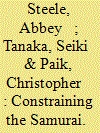| Srl | Item |
| 1 |
ID:
184108


|
|
|
|
|
| Summary/Abstract |
Suzuki Bokushi (1770–1842) was a peasant-entrepreneur, essayist and amateur haikai poet who lived in the Echigo province of Tokugawa period Japan, a region which gets the highest amount of snowfall in the world. Bokushi wrote about the people of his region, their customs, their lifestyle, their relationship with the natural world and the folklores of the region in a book entitled Hokuetsu Seppu (1837). This essay will examine the ways this book interrogated the dominant cultural discourse and offered new ways of thinking about centre and periphery, urban and rural. An analysis of the text and context of the book will show how ‘provinciality’ was deployed to question and de-centre prevailing cultural norms, and how a new aesthetic sense was developed that contrasted and questioned the urban sensibilities prevailing in the political centre. This essay will argue that Bokushi’s book articulates a significant critique of the urban-centric discourse of classical Japanese literature, while also offering an alternative rural aesthetic, thereby countering the hegemonic tendency to read the Japanese past through the lens of urban-centric literature. His writings are what Fredric Jameson would call a ‘nonhegemonic cultural voice’.
|
|
|
|
|
|
|
|
|
|
|
|
|
|
|
|
| 2 |
ID:
155494


|
|
|
|
|
| Summary/Abstract |
On the eve of the Meiji Restoration in 1868, the nearly 300 semi-autonomous domains across Japan had widely varying tax rates. Some handed over 70 percent of their rice yield to the samurai ruler of the domain, while others provided 15 percent. This variation existed in spite of the similar fiscal demands that the domain rulers faced within the Tokugawa regime—the feudal system that governed Japan between 1603 and 1868. This period was remarkably stable; Japan saw no foreign or domestic wars. This allows us to focus on the impact of pressure from below on taxation. We study the extent to which peasant-led rebellions and collective desertion (“flight”) lowered the subsequent tax rate imposed by samurai rulers. Using newly compiled data on different types of peasant-led political mobilization—from petitions to insurrections—we find an association between, on the one hand, large-scale rebellions and flight and, on the other, lower tax rates. We interpret the results as evidence of rebellious or mobile peasants’ ability to constrain their rulers; the more complacent fail to win concessions. Our findings suggest that peasant mobilization played a role in restricting state growth in early modern Japan through tax concessions.
|
|
|
|
|
|
|
|
|
|
|
|
|
|
|
|
| 3 |
ID:
123488


|
|
|
|
|
| Publication |
2013.
|
| Summary/Abstract |
This paper examines the way the outcaste head Danzaemon, or more precisely several individuals who successively bore that title, negotiated their place in the eighteenth-century Edo status order through official genealogical pronouncements. Eta and hinin groups became closely linked together in the political imaginary in Edo from around the beginning of the eighteenth century in an extraordinary legal battle that emerged between the leaders of these groups. The head of the former group, Danzaemon Chikamura, achieved a qualified victory in this struggle through genealogical posturing, positioning himself at the apex of an increasingly well-defined Edo outcaste order. By the second half of the eighteenth century, the privileged place within the order held by the next Danzaemon came under renewed pressure from a new generation of hinin. As a result, Danzaemon Chikasono made an attempt to rearticulate the grounds for his status through a different kind of genealogical statement. This article, using the official correspondence between Danzaemon and the Edo City Magistrate, examines the distinctive features of the genealogical imaginations of these two outcaste leaders in order to reveal the ways they negotiated their place within the Edo outcaste order.
|
|
|
|
|
|
|
|
|
|
|
|
|
|
|
|